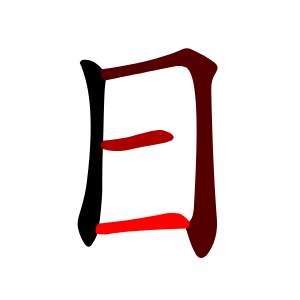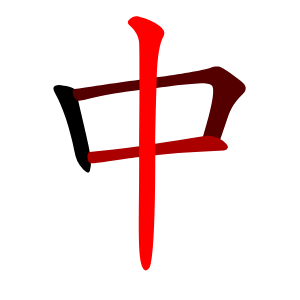The purpose of this project is to display kanji and kana (Japanese characters) or hanzi (simplified and traditional Chinese characters) stroke by stroke.
For a demo, see http://gooo.free.fr/animCJK/official
For each character, there is one or several svg files in AnimCJK repository that contains paths defining its shape and some css code to animate it. The name of the svg is the decimal unicode of the character followed by the "svg" extension.
SVG files are stored in several folders.
The svgsJa folder contains svg files corresponding to the union of the Japanese "jōyō kanji" (2136 characters) and the Japanese "jinmeyō Kanji" (862 characters). As a result, svgsJa folder contains 2998 characters.
The svgsKana folder contains svg files corresponding to the Japanese "hiragana" (86 characters) and Japanese "katakana" (91 characters). As a result, svgsKana folder contains 177 characters.
The svgsZhHans folder contains svg files corresponding to Chinese "commonly used simplified hanzi" (7000 characters). This set includes the "HSK hanzi" (2663 characters) and the "frequently used simplified hanzi" (3500 characters).
The svgsZhHant folder contains svg files corresponding to Chinese "HSK 1 traditional hanzi" (197 characters). Note that some simplified characters have more than one corresponding traditional character.
Take care because characters are not always the same in Japanese and in Chinese even when they share the same unicode. For instance 勉 (21193.svg) in Japanese has not the same shape as 勉 (21193.svg) in Chinese.
Take care of compatibility characters such as 勉 (64051.svg) that has in Japanese the same shape as 勉 (21193.svg) in Chinese, but has not the same unicode.
Each svg can be inserted as is in a web page, or with some modifications using for instance javascript.
First, you have to download animCJK somewhere on your computer (then evenly upload it on a webserver).
Just insert a svg file representing a character as is in a web page.
For instance, you can use php (assume that you moved or uploaded animCJK repository on a php server). Write the code below in a file called simple.php and store it in the samples folder of AnimCJK. Then run simple.php in a browser.
<!doctype html>
<html>
<head>
<meta charset="UTF-8">
<meta name="viewport" content="initial-scale=1.0,user-scalable=yes">
<style>
svg.acjk
{
width:256px;
height:256px;
}
</style>
<title>Simple usage of AnimCJK</title>
</head>
<body>
<h1>Simple usage of AnimCJK</h1>
<?php
include "../svgsJa/20013.svg"; // include Japanese 中
?>
</body>
</html>
Alternately, you can use HTML and Javascript. Write the code below in a file called simple.html and store it in the samples folder of AnimCJK. Then run simple.html in a browser.
<!doctype html>
<html>
<head>
<meta charset="UTF-8">
<meta name="viewport" content="initial-scale=1.0,user-scalable=yes">
<title>Simple usage of AnimCJK</title>
<style>
svg.acjk
{
width:256px;
height:256px;
}
</style>
</head>
<body>
<h1>Simple usage of AnimCJK</h1>
<div id="svgBox"></div>
<script>
function loadSvg()
{
var xhr=new XMLHttpRequest();
xhr.onreadystatechange=function()
{
if ((xhr.readyState==4)&&(xhr.status==200))
document.getElementById("svgBox").innerHTML=xhr.responseText;
};
xhr.open("GET","../svgsJa/20013.svg",true); // get Japanese 中
xhr.send(null);
}
window.addEventListener("load",loadSvg,false);
</script>
</body>
</html>
You can insert svg files as HTML code in Anki card's note fields.
For instance, using Anki card editor, select "Recto" field of a card's note, then click on the "hamburger" icon, select the menu that allows to modify the HTML and paste the content of any AnimCJK svg file representing a character anywhere in the HTML code.
Several samples are provided to show how to use AnimCJK. These samples are stored in the samples folder. See also http://gooo.free.fr/animCJK/official/samples
Using php, javascript or any other languages, you can easily modify svg files in order to change size of characters, colors, animation duration, etc.
- to insert several characters in the same page, see animeSeveral.html.
- to change colors of a character, see color.php and red.php.
- to change the size of a character, see size.php.
- to change the speed of drawing a character, see speed.php.
See other samples for more usages.
Some browsers (notably Microsoft browsers) cannot animate svg properly. A workaround for these browsers is provided with the samples.
However, the market share of these browsers is constantly decreasing. So it is conceivable (in 2018) to remove this workaround to simplify your code.
To animate a character, AnimCJK uses the following method: the character shape is split in several paths (one per stroke). These paths (called "stroke" paths) are used as clip-path, and dashed lines (called "median" paths) are drawn over these paths. The space between two dashes is large enough to cover the whole path. Initially, the path is covered by a space of the dashed line. Using a css animation, one moves the position of the dashed line. As a result, one has the impression that the strokes are drawn gradually. See https://css-tricks.com/svg-line-animation-works/ for more details.
If several characters are inserted in the same page (for instance if one want to display "一二三"), and if one need to animate them one after the other, one has to modify the animation-delay of each stroke in the css of the svg. If a character is displayed several times in the same page (for instance if one want to display "谢谢"), one also need to modify the id of its elements. This can be done using javascript. Alternately, one can encapsulate each svg in an iframe.
Note: some kana (those which have a stroke overlapping on itself as あ, ぬ etc.) are special. The stroke which overlaps is split in several parts. So automatic procedures on these characters require some specific codes.
Note: some characters have special versions stored in folders that have the "Special" suffix. These versions have some strokes split in several parts in order to be able to show the radical of characters like 由, 甲, etc. See "Radical" sample to see how it works. If you don't intend to show the radical of characters in a different color when drawing a character, you don't need to use these special versions.
To display components of a character in different colors, a specific decomposition system to AnimCJK called "acjk" can be used. "acjk" decompositions are stored in dictionaryJa.txt, dictionaryZhHans.txt, etc.
An "acjk" decomposition starts with a character, followed by its number of stroke (which indicates that the character is not decomposed), or followed by an ideographic description character (which indicates that the character is decomposed). The ideographic description character is followed by several component decompositions (3 for "⿲" and "⿳", 2 for ⿰","⿱","⿴","⿵","⿶","⿷","⿸","⿹","⿺" and "⿻). If a component has no corresponding character to represent it, its decomposition just starts with the ideographic description character. If a component has no corresponding character to represent it and no decomposition, its decomposition starts by a "?" followed by its number of stroke. A component may be represented by a character that has more strokes than it, followed by the decomposition of the component instead of the representing character. A component may be represented by a character that has a different glyph, but is semantically the same as the component. Special case 1: when a component is also the radical of the main character, a special mark is inserted just after the component character (actually a "."). Special case 2: sometimes, a component is split in several parts (when some strokes of other components are drawn "between" its parts). In such a case, each part is represented by a specific decomposition starting with the component character which is split, followed by a special mark (actually a ":"), followed by the decomposition of this part. When there is more than one special mark, the radical special mark is inserted first. It is mandatory to decompose a component which contains the radical of the main character. It is optional to decompose other components. If a character has several possible decompositions, just concatenate them.
A plugin for Wordpress to insert animated kanji in a webpage using BBCode can be downloaded at:
http://gooo.free.fr/animCJK/animkanji_wp_plugin_page.php
This project is derived from the remarquable Makemeahanzi project which is designed to display Chinese characters. See https://github.com/skishore/makemeahanzi for more details. Many characters were modified or added in AnimCJK (between three or four thousand at the moment) for various reasons:
- many Japanese characters have a different stroke order, or have a different glyph, or have a different stroke direction or are not commonly used in Chinese, and therefore have no entry in Makemeahanzi.
- many Chinese traditional characters have a different stroke order, or have a different glyph, or have a different stroke direction or have no entry in Makemeahanzi.
- many character shapes were just slightly modified to look prettier.
- some commonly used (but not frequently used) Chinese characters have no entry in Makemeahanzi.
Even if character shapes have the same look in both Makemeahanzi and AnimCJK, the svg files are different: the css is different, the svg structure is different, the coordinate system is different, the stroke paths are different, the median paths are different. However, for people who would like to re-import characters from AnimCJK to Makemeahanzi, text files are provided (graphicsJa.txt, graphicsZhHans.txt, etc.) that have the same format as the graphics.txt file of Makemeahanzi. So it is easy to generate SVG files in the format used by Makemeahanzi using AnimCJK data.
Makemeahanzi itself makes an extensive use of the Arphic PL KaitiM GB and Arphic PL UKai fonts generously provided by Arphic Technology.
Many characters of AnimCJK are not present in these fonts (especially but not exclusively Japanese characters since these Arphic fonts are designed for Chinese). One used parts of other characters to design these missing characters and/or used various editors (mainly Inkscape and BBEdit) to modify their shape. One didn't use any other fonts to make these characters.
Some samples use Animated_GIF.js script.
Animated_GIF.js script comes from Animated_GIF project.
Part of magicAcjk.js script is derived from Animated_GIF sample called "basic".
See https://github.com/sole/Animated_GIF for more details about Animated_GIF project.
Some javascript scripts use polyfills for String.codePointAt and String.fromCodePoint functions. These polyfills are stored in codePoint.js script.
These polyfills come from https://github.com/mathiasbynens/String.codePointAt and https://github.com/mathiasbynens/String.fromCodePoint projects.
We used various sources to cross-check our data. In particular:
- Wiktionary, https://en.wiktionary.org/ (all characters)
- Kakijun, https://kakijun.jp/ (Japanese characters)
- KanjiVG, http://kanjivg.tagaini.net/viewer.html (Japanese characters)
- ArchChinese, https://www.archchinese.com/chinese_english_dictionary.html (Chinese characters)
- Taiwanese Minister Of Education, https://stroke-order.learningweb.moe.edu.tw/characters.do?lang=en (Chinese characters used in Taiwan)
- Hong-Kong Education Bureau, https://www.edbchinese.hk/lexlist_en/ (Chinese characters used in Hong-Kong)
- Naver Hanja Dictionary, https://hanja.dict.naver.com/ (Korean characters)
- OpenCC, https://github.com/BYVoid/OpenCC (correspondence between simplified and traditional Chinese characters)
- Commons Chinese characters decomposition, https://commons.wikimedia.org/wiki/Commons:Chinese_characters_decomposition (Chinese characters decomposition)
- CJK Decomposition Data, https://archive.codeplex.com/?p=cjkdecomp (Chinese characters decomposition)
- Hanzi Yuan, http://hanziyuan.net/ (Chinese characters etymology)
- Shufa Ai, http://www.shufaai.com/a/zidian/zi/ (various images of Chinese characters)
- How SVG Line Animation Works, https://css-tricks.com/svg-line-animation-works/
2021/06/20:
- fix a error in the median of the 5th stroke of 抽
2020/07/23:
- improve "の"
2019/04/29:
- replace 卜 by ⺊ in decomposition of 上, 占, etc.
2019/03/28:
- fix bug in 12388.svg (つ kana).
2019/01/27:
- various minor updates,
- various shape and stroke order updates.
2018/12/16:
- remove css calc() from svg files (poorly supported),
- various shape and stroke order updates.
2018/12/14:
- add Infinite sample,
- various minor updates.
2018/12/07:
- add traditional hanzi for HSK 1 (197 characters),
- rewrite all the samples,
- support of browsers that cannot animate SVG properly in samples,
- various minor shape or stroke order updates,
- various other minor updates.
In summary, you can freely redistribute and/or modify the files of this project under the terms of 3 licenses:
- Arphic Public License (files prefixed by "graphics" and SVG files excepting those that are in svgsKana folder),
- MIT license (Animated_GIF.js and codePoint.js scripts),
- GNU Lesser General Public License (all other files including SVG files that are in svgsKana folder).
See https://github.com/parsimonhi/animCJK/blob/master/licenses/COPYING.txt for more details about licences concerning this project.

